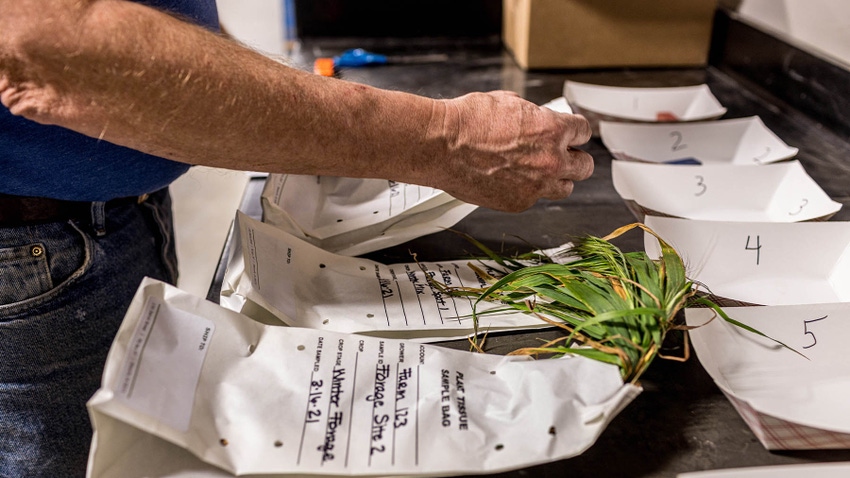June 15, 2023

Source: AgriSource
“If you can't measure it, you can't manage it.” That is especially true in crop production. Plant tissue testing provides accurate, real-time measurements to inform your decision-making throughout the growing season. Establishing a tissue sampling program and setting benchmarks for specific crop nutrients allows you to manage for more yield potential and savings.
“We often use crop planning to set up our fertilizer passes but don’t measure their impact on the crop or evaluate the outcome of those applications,” says Garret Johns, agronomic support specialist with AgSource. “That’s where plant tissue testing comes in. This precise measurement tool allows you to accurately adjust your fertility program by proactively identifying and removing yield-limiting factors.”
With fertilizer making up to 36% of a farmer’s operating cost in raising corn[1] and about 15% of soybean input costs, it pays to measure and manage this investment through a comprehensive plant tissue testing program.
Here are four reasons why you should be plant tissue testing:
1. Make informed adjustments to your fertilizer program
Accurate data from plant tissue testing allows you to take action to support your crops mid-season. You can use the insights to sharpen your program – increasing yields or saving on fertilizer costs by being more precise, timely and accurate with your applications.
“Plant tissue testing helps you identify your fertilizer strategy and fertilizer placement,” says Johns. “Through tissue testing, you don’t have to wait until harvest to see if the fertilizer is getting in the plant. You can evaluate it throughout the growing season and validate or adjust the strategy to achieve your goals.”
One example of improving yield through plant tissue testing is adjusting split-applied nitrogen during a wet spring.
“With heavy rains, we know some early applied nitrogen is lost,” says Johns. “Plant tissue sampling can help us determine the timing for a second application and how much nitrogen to apply, leading to stronger yields.”
2. Know what nutrients your crop is using (and what to do about it)
While there are visual indicators of plant health (e.g., the crop looks good), every field and soil type differs. You may know how much nitrogen, phosphorous, potassium and micronutrients you apply each year. But, without consistently analyzing plant tissue and soil, knowing how much makes its way into the crop is nearly impossible.
“It is important to know your nutrient levels throughout the growing season and where they should be,” says Johns. “Plant tissue testing reports provide a current measurement of each nutrient and a range with an upper and lower limit.”
As you interpret the data from your tissue samples, it is a good practice to work with your local agronomist to develop a plan to remedy any nutrient deficiencies.
“The most common problems we diagnose through plant tissue testing are nitrogen, phosphorus and boron deficiencies. We also see zinc, sulfur and molybdenum issues,” says Johns.
3. Support the crop at crucial growth stages
While testing across the entire season brings the most comprehensive results, there are a few specific times when it is most critical.
“The ideal timing for tissue testing corn is just before tassel and grain fill. For soybeans, it is flowering and pod fill,” says Johns. “These are times when we know we don’t want the plant to be deficient and when we have the most opportunity to influence the plant’s growth.”
Quality nutrition during these critical reproductive stages can lead to improved yields. If a corn plant is well-fed and has low stress during tassel, it stands a much higher chance of complete and effective pollination.
4. Capture trends for specific nutrients over time
“A tissue sample is just one point in time. This is exactly what is in the plant on Wednesday at 1:55 in the afternoon. At 2:15 it’s going to be different,” says Johns.
Just as your blood pressure can vary from hour to hour, so can the nutrient levels in your fields. Capturing data across multiple points allows you to identify trends and changes over time to address what is happening in the field more accurately.
Through consistent plant tissue testing over multiple years, your plant tissue testing laboratory can compile custom trends and averages into reports to show what common problems occur season after season. You can also see the response of various applications in addressing issues given enough samples before and after fertilizer application.
Consistent plant tissue testing throughout the growing season provides you with actionable agronomic data to fine-tune your fertilizer decisions. Contact your local agronomist or visit agsource.com to get started.
AgSource is a broad-based agricultural service cooperative specializing in laboratory testing and value-added dairy management information. AgSource has become a leader in agricultural and environmental laboratory analysis and information management services and is one of the only full-service DHI providers in the country. In cooperation with our partners, AgSource strives to increase research and development of improved management decision tools, working together for the overall benefit of our members and customers and the agriculture industry.
You May Also Like




